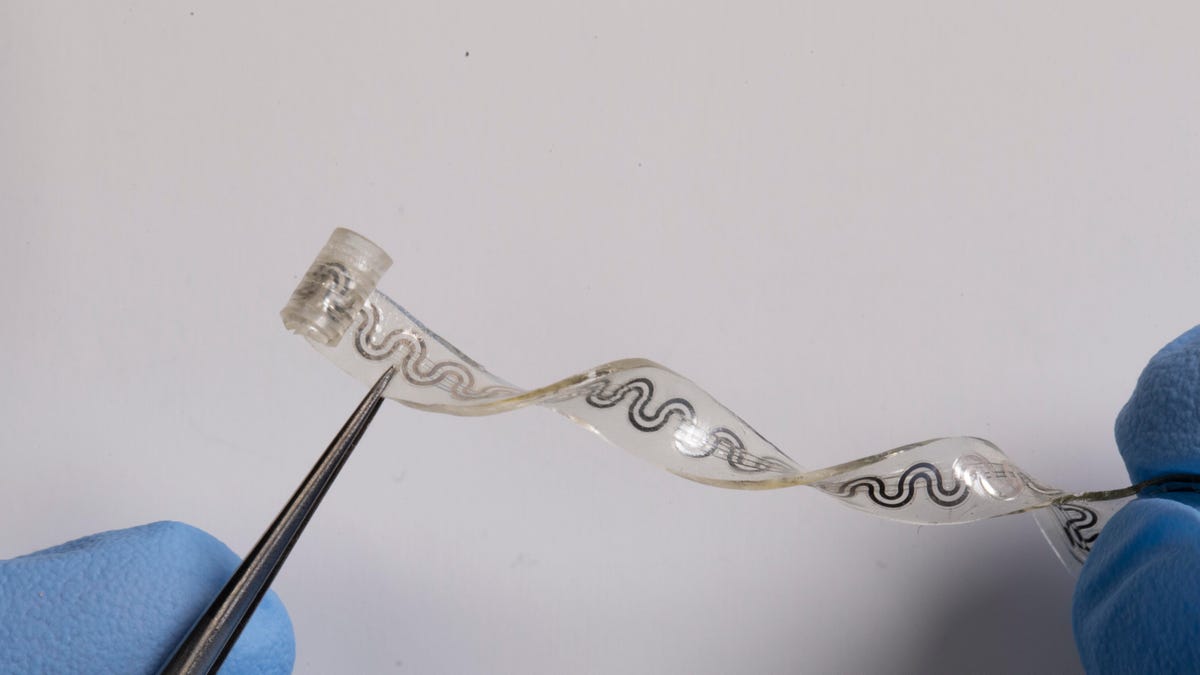This Stretchy Device Wraps Around Nerves to Relieve Pain Without Drugs

Northwestern researchers' pain relief device is about 5 millimeters wide and as thin as a sheet of paper, flexible and soft enough to wrap around nerves without causing damage.
What's happening
A new type of pain relief involves wrapping a tiny strip of material around nerves to prevent them from sending pain signals to the brain.
Why it matters
If this prototype passes all necessary safety and experimental trials, it could one day replace toxic opioids for patients who live with chronic pain.
On Thursday, Northwestern University researchers announced they've developed a fresh, new angle on pain relief -- and critically, one that doesn't require the use of highly addictive opioids.
It's a small, soft, stretchy device that can be implanted under a patient's skin to gently wrap around nerves responsible for troubling pain signals. Typically, when such signals reach the brain, that's when you feel a prick, ache, burn or other type of painful sensation.
Once in place, the material -- about the thickness of a sheet of paper -- basically employs a cooling effect to numb those nerves, blocking unwanted pain signals from traveling to the brain at all. Think of it like how your fingers start to feel numb when they're super cold. If they hurt before, they probably don't anymore.
Better yet, once the device has fulfilled its duties, it dissolves naturally into the body like an absorbable stitch. No surgical extraction required. Details of the design, which notably is still a prototype, will be published in the July 1 issue of the journal Science.
"As you cool down a nerve, the signals that travel through the nerve become slower and slower -- eventually stopping completely," Matthew MacEwan of Washington University School of Medicine in St. Louis and study co-author said in a statement. "We are specifically targeting peripheral nerves, which connect your brain and your spinal cord to the rest of your body."
"By delivering a cooling effect to just one or two targeted nerves," MacEwan continued, "we can effectively modulate pain signals in one specific region of the body."
Illustration of the implantable device inside an arm. The red oval indicates pain. The device softly wraps around the peripheral nerve to silence signals to the brain.
Plus, the person using the device can remotely control the intensity of pain relief, aka the cooling effect, that it delivers, according to their individual needs. It's an aspect of the invention that's as fascinating as it is vital.
The cooling mechanism works because the device is embedded with microfluidic channels, which are tubes that can be manipulated with very high precision -- this allows you to let fluid in or out at will, without error. And all the fluids contained in the new device's channels collaborate to create the pain-numbing, cooling effect. Through these microfluidics, you can essentially govern how much of each fluid is inside to determine how intense the cooling is.
It's that kind of precise control through remote microfluidics that avoids the potentially dangerous side effects of other methods.
"Excessive cooling can damage the nerve and the fragile tissues around it," John A. Rogers of Northwestern University's McCormick School of Engineering and Applied Science, who led the device development, said in a statement. "The duration and temperature of the cooling must therefore be controlled precisely."
The researchers pointed to other "cooling therapies" that have been tested for pain relief in the past, like one that injected cooling liquid into the body with a needle, meaning it couldn't be meticulously controlled. This could potentially lead to things like blocking the wrong nerves, such as those important to run motor function so you're able to move your hand.
"You don't want to inadvertently cool other nerves or the tissues that are unrelated to the nerve transmitting the painful stimuli," MacEwan said.
In the grand scheme of things, Rogers, MacEwan and fellow researchers are focused on finding new ways to give patients pain relief without the use of drugs -- namely, opioids -- because "although opioids are extremely effective, Rogers said, "they also are extremely addictive."
In 2021, the US Centers for Disease Control and Prevention reported that there were an estimated 100,306 drug overdose deaths in the States, 75,673 of which were attributed to opioids. And over the past 21 years, opioid overdose has been the driver for over a half a million deaths, according to a 2021 study. And if you're slightly confused about the relationship between those two figures – it's because fatalities have grown sharply since 2013.
It's a really difficult situation because many people rely on opioids to live a life without excruciating pain, but every time you ingest an opioid, you're putting yourself at risk of addiction. So do you pick the riskier, painless lifestyle or the safer, painful one?
Well, if the newly announced device does well with all subsequent trials, many people worldwide may not have to choose either. This would be option three.
"As engineers, we are motivated by the idea of treating pain without drugs -- in ways that can be turned on and off instantly, with user control over the intensity of relief," Rogers said. "Our implant demonstrates in animal model studies that this effect can be produced in a programmable way, directly and locally to targeted nerves, even those deep within surrounding soft tissues."

